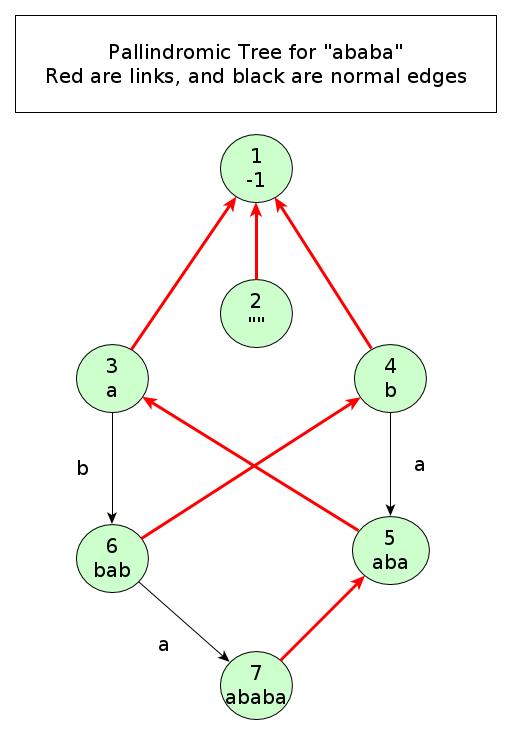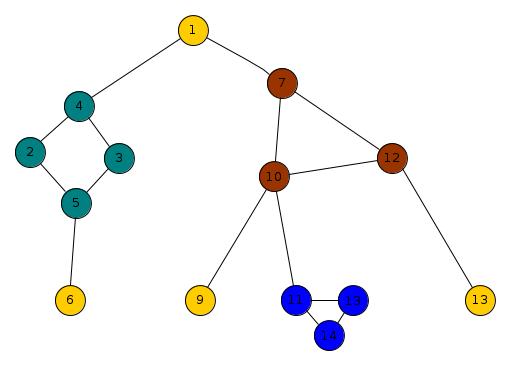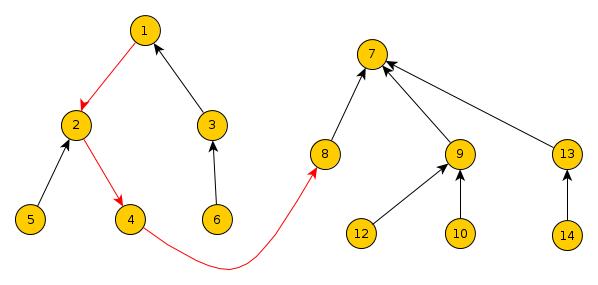Category: Data Structure, Persistent segment Tree
Solution:
See official Editorial here for understanding the basics.
Implementation:
#include<bits/stdc++.h>
using namespace std;
/*------- Constants---- */
#define Long long long
#define Ulong unsigned long long
#define forn(i,n) for( int i=0 ; i < n ; i++ )
#define mp(i,j) make_pair(i,j)
#define pb(a) push_back((a))
#define SZ(a) (int) a.size()
#define all(x) (x).begin(),(x).end()
#define gc getchar_unlocked
#define PI acos(-1.0)
#define EPS 1e-9
#define xx first
#define yy second
#define lc ((n)<<1)
#define rc ((n)<<1|1)
#define db(x) cout << #x << " -> " << x << endl;
#define Di(x) int x;scanf("%d",&x)
#define min(a,b) ((a)>(b) ? (b) : (a) )
#define max(a,b) ((a)>(b) ? (a):(b))
#define ms(ara_name,value) memset(ara_name,value,sizeof(ara_name))
/*************************** END OF TEMPLATE ****************************/
const int N = 2e5+500;
int n,m,sz;
vector<pair<int,int> > G[N];
int root[N];
long long B = 37;
long long MOD = 1e9 + 7;
long long POW[N], POWER[N];
int zero;
struct Node
{
int ls,rs;
int cnt;
long long hash;
} node[N*40];
void build(int &n,int b,int e)
{
n = ++sz;
if(b==e) {
node[n].hash = node[n].cnt = 0;
return;
}
int mid = (b+e)/2;
build(node[n].ls, b, mid);
build(node[n].rs, mid+1,e);
node[n].cnt = node[node[n].ls].cnt + node[node[n].rs].cnt;
node[n].hash = node[node[n].ls].hash + POW[mid - b + 1] * node[node[n].rs].hash;
}
void update(int &n,int pre,int b,int e,int pos)
{
n = ++sz;
node[n] = node[pre];
if(b==e && b == pos) {
node[n].hash = 1;
node[n].cnt = 1;
return;
}
int mid = (b+e)/2;
if(pos <= mid) update(node[n].ls, node[pre].ls , b, mid, pos);
else update(node[n].rs, node[pre].rs, mid+1,e,pos);
node[n].cnt = node[node[n].ls].cnt + node[node[n].rs].cnt;
node[n].hash = node[node[n].ls].hash + POW[mid - b + 1] * node[node[n].rs].hash;
}
void updateRange(int &n,int pre,int id2 , int b,int e,int i, int j)
{
n = ++sz;
node[n] = node[pre];
if(b>j || e < i) return;
if(b >= i && e <= j ) {
node[n] = node[id2];
return;
}
int mid = (b+e)/2;
updateRange(node[n].ls, node[pre].ls, node[id2].ls, b, mid, i, j);
updateRange(node[n].rs, node[pre].rs, node[id2].rs, mid+1,e,i, j);
node[n].cnt = node[node[n].ls].cnt + node[node[n].rs].cnt;
node[n].hash = node[node[n].ls].hash + POW[mid - b + 1] * node[node[n].rs].hash;
}
int query(int n,int b,int e,int i,int j)
{
if(b>j||e<i) return 0;
if(b>=i&&e<=j) return node[n].cnt;
int mid = (b+e)/2;
return query(node[n].ls, b, mid, i, j) + query(node[n].rs, mid+1,e,i,j);
}
int find(int root,int w)
{
int low = w, high = N , mid, ans = w - 1;
while(low <= high) {
mid = (low + high ) /2;
int oo = query(root,0,N,w,mid);
if( oo == mid - w+ 1) {
ans = mid ;
low = mid+1;
}
else high = mid-1;
}
return ans + 1;
}
bool queryIn(int r1 ,int r2, int b,int e)
{
if(b==e) {
return node[r1].hash > node[r2].hash;
}
int mid = (b+e)/2;
if( node[node[r1].rs]. hash == node[node[r2].rs]. hash ) return queryIn(node[r1].ls, node[r2].ls, b , mid ) ;
else return queryIn(node[r1].rs, node[r2].rs, mid+1,e);
}
long long tot = 0;
void Trv(int n,int b,int e)
{
if(b==e) {
if(node[n].hash) {
tot += POWER[b];
tot %= MOD;
}
return;
}
int mid = (b+e)/2;
Trv(node[n].ls, b, mid);
Trv(node[n].rs, mid+1,e);
}
void show(int r,int b , int e)
{
if(b==e) {printf("%lld",node[r].hash);
return;
}
int mid = (b+e)/2;
show(node[r].ls, b , mid);
show(node[r].rs , mid+1,e);
}
struct Vertex
{
int id;
int r;
bool operator<(const Vertex &p) const {
return queryIn(r,p.r,0,N);
}
} vlist[N];
bool vis[N];
int F[N];
bool see[N];
void print(Vertex x)
{
printf("Value of %d : ", x.id);
show(x.r,0,N);
cout << endl;
}
void dij(int s,int t)
{
Vertex S = {s,zero};
//print(S);
priority_queue<Vertex> pq;
pq.push(S);
while(!pq.empty()){
Vertex u = pq.top(); pq.pop();
if(vis[u.id]) continue;
vis[u.id] = 1;
if(u.id == t) break;
for(auto a : G[u.id]) {
int v = a.first, w = a.second;
if(vis[v]) continue;
int ho = find(u.r,w);
int tmp, tmp2;
update(tmp, u.r, 0, N , ho );
updateRange(tmp2, tmp, zero, 0, N , w, ho - 1);
Vertex T = {v, tmp2};
//print(T);
if(see[v] == 0 || vlist[v] < T ) {
vlist[v] = T;
see[v] = 1;
F[v] = u.id;
pq.push(vlist[v]);
}
}
}
if(vis[t]) {
Trv(vlist[t].r, 0, N);
cout << tot << endl;
vector<int> ans;
while(t!= s) {
ans.pb(t);
t = F[t];
}
ans.pb(s);
reverse(all(ans));
printf("%ld\n",ans.size());
for(auto a: ans ) printf("%d ",a);
printf("\n");
}
else printf("-1\n");
}
int main()
{
//freopen("in.txt","r",stdin);
scanf("%d %d",&n,&m);
POW[0] = POWER[0] = 1;
for(int i = 1; i < N; i ++ ) POW[i] = (POW[i-1] * B) % MOD, POWER[i] = (POWER[i-1] * 2) % MOD;
for(int i = 0; i < m ; i ++ ) {
int a,b,x;
scanf("%d %d %d",&a,&b,&x);
G[a].pb(mp(b,x));
G[b].pb(mp(a,x));
}
build(zero,0,N);
int s,t;
scanf("%d %d",&s,&t);
dij(s,t);
return 0;
}





